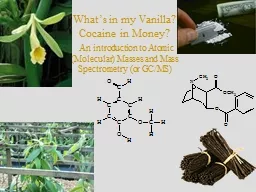

Cocaine in Money An introduction to Atomic Molecular Masses and Mass Spectrometry or GCMS Every atom has a certain number of protons neutrons and electrons Z atomic number number of protons in an element also determines which element you have X ID: 565935
Download Presentation The PPT/PDF document "What’s in my Vanilla" is the property of its rightful owner. Permission is granted to download and print the materials on this web site for personal, non-commercial use only, and to display it on your personal computer provided you do not modify the materials and that you retain all copyright notices contained in the materials. By downloading content from our website, you accept the terms of this agreement.
Slide1
What’s in my Vanilla?Cocaine in Money? An introduction to Atomic (Molecular) Masses and Mass Spectrometry (or GC/MS)Slide2
Every atom has a certain number of protons, neutrons, and electrons.Z = atomic number (number of protons in an element, also determines which element you have, X)X = abbreviation for the elementA = mass number (total number of protons and neutrons in a particular isotope of that element)For a neutral atom, the number of electrons is equal to Z. If the atom is has a charge of +n, the number of electrons is equal to Z-n, if a charge of –n, the number of electrons is equal to Z+nSlide3
Complete the following table.
Symbol
Z
N
A
# elec.
12
C
-
15
31
13
6
11
5
Bi
3+
126Slide4
Isotopes of an element contain the same number of protons (i.e. the same element) but different numbers of neutronsExamples:
Isotopes do not have to be radioactive
Many elements contain more than one naturally occurring isotope, a few have only oneSlide5
Problem: if we know the number of protons and electrons in an atom, can we get the mass of an atom?Possible solution: can we add up the masses of the individual nucleons?(mp) = 1.673 X 10-27 kg(m
e) = 9.11 X 10-31 kg(mn
) = 1.675 X 10-27 kgLet’s try this for H and DSlide6
Problem: The masses of H and D are known to be: 1.674 X 10-27 kg and 3.344 X 10-27kgWe can’t add up the individual masses because when the nucleons combine to form atoms some of their mass is converted into energy to hold the nucleus together (binding energy)What do we do?Slide7
Let’s choose a standard atomic mass unit (amu). Then we can measure the masses of all the atoms relative to that.Definition: 1 atom of carbon-12 has a mass of exactly 12 amu or 1 amu is exactly ½ the mass of a carbon-12 atom.Using this definition, 1 amu ( 1u) = 1.6605387 X 10-27 kg, H has a mass of 1.007825 amu , D has a mass of 2.0140 amuSlide8
Problem: Now that we’ve defined a standard, how do we measure masses of all the other atoms relative to that standard?One solution: use a mass spectrometer that has been calibrated to the carbon-12 standard.Slide9
A mass spectrometer can measure mass to charge ratio of particles (single atomsor groups of atoms)Slide10
The mass spectrum is isotope specificSlide11
The atomic mass of an atom on the periodic table is really an average mass
average relative atomic mass = A1p1 + A2
p2 + … + AnPn
An = exact mass of specific isotopep
n = fractional abundance of isotopeSlide12
ExampleChlorine contains two naturally occurring isotopes: chlorine-35 (mass 34.968852 amu, 75.77% natural abundance) and chlorine-37 (mass 36.965903, 24.23% natural abundance). What is the average mass of chlorine?Slide13
OK, so what does this have to do with vanilla?Natural vanilla is extracted from the vanilla orchidNatural vanilla may contain more than one flavoring componentSometimes natural vanilla can be adulterated with coumarin; this reduced costs, but is illegal because coumarin is hepatotoxic.
Artificial vanilla is produced from wood pulpThe chief constituent
of both forms of vanilla is vanillin, C8H8
O3Slide14
Problem: What is the molecular mass of a molecule of vanillin containing only 12C? one 13C?Slide15
OK, so what does this have to do with vanilla?The metabolic pathway by which the vanilla orchid fixes carbon is different than that by which trees (used for wood pulp) do. This gives a slightly different 12C to 13C ratio.Using a high resolution mass spectrometer, we could measure the abundances of the
12C and 13C peak and determine the ratio to determine whether or not a sample is natural.
We probably won’t be able to make this distinction on our mass spectrometer, but...Slide16
Practice Sheet ObjectivesUnderstand mass spectroscopyUnderstand chromatographyUse GC/MS to examine differences between artificial vanilla extract, real vanilla extract,
and vanilla beansIdentify minor flavoring
components, preservatives, etc.Identify coumarin
as an illegal additive.Slide17
Gas Chromatography Mass SpectroscopyDetermine MM of a compound (mass of a molecule)
Determine structure of a compound
Determine ID of unknownUsed in conjunction
with GC to separate, determine, and quantify mixturesSlide18
A gas chromatograph will separate mixtures into components. This will lead to a chromatogram.Slide19
Each peak in a chromatogram has its own mass spectrum.mesitylene, C9H12
Other peaks are due to
fragmentation of the molecule in the mass spec.Slide20
What Else Can We do With Mass Spectroscopy?Arson analysisDrug analysisTrace analysis